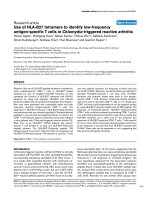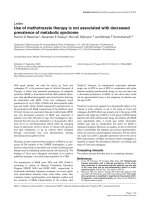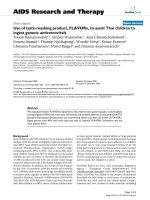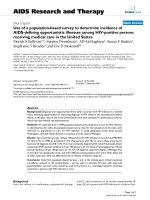Báo cáo y học: " Use of near-infrared light to reduce symptoms associated with restless legs syndrome in a woman: a case report" docx
Bạn đang xem bản rút gọn của tài liệu. Xem và tải ngay bản đầy đủ của tài liệu tại đây (355.49 KB, 5 trang )
CAS E REP O R T Open Access
Use of near-infrared light to reduce symptoms
associated with restless legs syndrome in a
woman: a case report
Ulrike H Mitchell
Abstract
Introduction: We describe a potential new treatment option for patients suffering from restless legs syndrome.
Contemporary treatment for restless legs syndrome consists mostly of dopaminergic drugs that leave some
patients feeling nauseated and dizzy. A non-invasive, drug-free option would open new doors for patients suffering
from restless legs syndrome.
Case presentation: A 69-year-old Caucasian woman met International Restless Legs Syndrome Study Group
criteria for the diagnosis of restless legs syndrome. She had been afflicted with restless legs syndrome for over
30 years and tried many of the available pharmaceutical remedies without success. For this study she received
30-minute treatment sessions with near-infrared light, three times a week for four weeks. The restless legs
syndrome rating scale was used to track symptom changes; at baseline she scored “27” on the 0 to 40 point scale,
which is considered to be “severe”. Our patient was almost symptom free at week two, indicated by a score of “2”
on the rating scale. By week four she was completely symptom free. The symptoms slowly returned during week
three post treatment.
Conclusions: The findings suggest that near-infrared light may be a feasible method for treating patients suffering
from restless legs syndrome. Undesirable side-effects from medication are non-existent. This study might revive the
neglected vascular mechanism theory behind restless legs syndrome and encourage further rese arch into this area.
Introduction
Restless legs syndrome (RLS) is a chronic sensorimotor
disorder, characterized by a strong urge to move,
accompanied or caused by uncomfortable or even dis-
tressing paresthesia of the legs, described as a creeping,
tugging, “pulling” feeling. The symptoms often become
worse throughout the day, leading to sleep disturbances
or deprivation and, consequently, to impairment of
alertness and daytime functions [1]. The symptoms are
usually lessened by movement [2].
The diagnosis of RLS is clinical and based on a
patient’s description o f the sympt oms. In an attempt to
standardizediagnosticprocedures,theInternational
Restless Legs Syndrome Study G roup (IRLSSG) identi-
fied four criteria to substantiate the diagnosis of RLS
[3]. To meet the criteria the patients had to answer the
four questions affirmatively. The questions explore
whether the subjects have an urge to move their legs,
whether the sympt oms begin or worsen during periods
of inactivity, whether the urge to move is at least par-
tially relieved by movement, and whether this urge to
move is worse in the evening or night [3]. The IRLSSG
also defined three supportive features. While they are
not essential to the diagnosis of RLS, their presence can
help resolve diagnostic uncertainty; they are: family his-
tory, presence of periodic limb movement and the
response to dopaminergic treatment [3].
The IRLSSG dev eloped the International Restless Legs
Scale (IRLS) for measuring s everity of the symptoms
and their impact on a person’s life [3]. The scale evalu-
ates and reflects subjective assessment of the primary
features, intensity, and frequency of the disorder and
associated sleep problems as well as the impact of the
symptoms on a patient’s mood and daily functioning [4].
The 10-question scale has five response options with an
Correspondence:
Department of Exercise Sciences, Brigham Young University, Provo, Utah
84602, USA
Mitchell Journal of Medical Case Reports 2010, 4:286
/>JOURNAL OF MEDICAL
CASE REPORTS
© 2010 Mitchell; licensee BioMed Central Ltd. Th is is an Open Access article distributed under the terms of the Creative Commons
Attribution License ( which permits unrestricted use, distribut ion, and reproduction in
any medium, provided the original work is properly cited.
associated score from “0” (no impact or symptoms) to
“4” (severe), yielding a maximum score of 40. Hoegl and
Gschliesser [5] reviewed several assessment tools used
for RLS patients. They strongly support the use of the
IRLS as the gold standard for assessing disorder severity.
They also recommend it as a tool to follow changes in a
subject’s status and suitable for repeated measurements.
The pathophysiology of RLS is not fully clear. RLS can
be classified in to primary or secondary forms, delineat-
ing genetic and idiopathic contrib utions or involvement
of other underlying pathologies respectiv ely. Secondary
RLS is usually dealt with by treating the underlying
causes or associated medical conditions. For primary
RLS dopaminergic medications are considered first line
treatment for their effectiveness and usual rapid and
dramatic improvement of the symptoms [6]. Other
drugs, such as opioids (methadone, hydrocodone),
GABA analogue (gabapentin, pregabalin), and ben zodia-
zepi nes (clonazepam) are also used to treat moderate to
severe RLS [6,7]. Until May 2005 there were no FDA-
approved drugs on the market for the treatment of RLS.
Now ropinirole and pramipexole, both dopamine ago-
nists, are available . Unfortunately these drugs can cause
insomnia, nausea, dyspepsia, and dizziness [8]. Since the
drugs only provid e symptomatic relief and are not con-
sidered a cure, the benefit of the treatment should jus-
tify any potential side effects and costs [6]. Non-
pharmacological treatment of RLS includes improving
sleep quality b y controlling sleep times, reducing caf-
feine and alcohol consumption, and maintaining a daily
moderate exercise program [9]. The efficacy of these
options has not been well documented and is limited.
Promising alternative treatment choices are welcomed
options. One of them might already be on the market,
but is currently used for other disorders: near-infrared
light (NIR). It is utilized for patien ts with neuropathy to
increase sensation and decrease pain. NIR ha s a wav e-
length of 880 nm to 890 nm and is emitted through
diodes [10]. For this case report Anodyne was used, but
there are other similar devices available for healthcare
providers. Anodyne is FDA approved for incr easing cir-
culation and reducing pain, and it has been successf ully
used in wound management [11]. Researchers hypothe-
size that the success of NIR treatment lies in its ability
to increase bioavailability of nitric oxide (NO) in the
lumen. In 1992 NO was hailed as the molecule of the
year for its significant role in vasoregulation, neurotrans-
mission, signal transduction, anti-microbi al defens e, and
digestion [12]. It is produ ced by the enzyme nitric oxide
synthase (NOS-3), which is activated by, among other
fact ors, shearing forces generated by blood flow that act
on the vascular endothelium [13]. Nitric oxide is also
found tightly bound to the hemoglobin contained in ery-
throcytes. It has been suggested that NO can be released
from this bond through intensive illumination [14].
Once generated, NO initiates a cascade o f events, lead-
ing to vasodilation and increased blood flow.
After being treated for neuropathy for 30 minutes
with NIR, three times a week for four weeks, three
patients reported that, while their neuropathy was bet-
ter, they were more excited that their RLS symptoms
had either decrease d or been eliminated. These findings
prompted this investigation into the effectiveness of NIR
therapy for the treatment of symptoms associated with
RLS.
Rationale
Treatment with NIR has been shown to increase blood
flow, possibly due to its ability to generate NO in the
endothelium. Nitric oxide has also been linked to
improved neurot ransmission. It is thus conceivable
that tissue treated with NIR could impact RLS, a neu-
rological disease, and decrease the symptoms asso-
ciated with it.
This cas e report was part of a randomized, controlled
study (not yet published), which was approved by the
institutional review board at Brigham Young University,
Provo, Utah.
The purpose of this report is, therefore, to describe an
investigation that was conducted on the e ffectiveness of
using NIR to decrease s ymptoms associated with RLS.
Written informed consent was obtained from the patient
for publication of this case report. A copy of the written
consent is available for review by the Editor-in-Chief of
this journal.
Case presentation
A respondent to a newspaper advertisement with symp-
toms of RLS, w as recruited for this case r eport. During
the evaluation she was asked about her symptoms–RLS
can only be diagnosed based on subjective findings–and
she met the four IRLSSG criteria [3].
Our patient was a 69-year-old Caucasian woman (1.63
m, 63.5 kg) who described her g eneral health status as
“good”. Her activity level was “reasonably active"; she
walked in the mornings and did some occasional yoga.
She did not complain of any mobility decreases and
enjoyed good flexibility. Her sleep pattern was disturbed,
mostly because of her RLS symptoms. Her urge to move
her legs was especially strong every evening. She had
difficulty falling asleep and could only do so after taking
zolpidem 10 mg (Ambien). She also reported having
been diagnosed with depression and had taken 20 mg
fluoxetine (Prozac) daily for almost 25 years. Our
patient never made a connection or noticed a correla-
tion between the antidepressant and RLS symptoms. She
complained of constant tiredness and fatigue, due to
restless sleep. Our patient was not aware of any other
Mitchell Journal of Medical Case Reports 2010, 4:286
/>Page 2 of 5
family member before her suffering from RLS. Her
fat her had “circulation problems” in his legs, but details
are unknown. However, both of her daughters, age d 43
and 39, reported symptoms of RLS. Neither of them was
taking medication for RLS. Our patient’s chief com-
plaints were painful sensations in her legs and hips, trig-
gering an urge to move the legs, as well as sleep
disturbance. Her social life suffered due to her inability
to sit still when going to the movies or the theater or
when flying in a plane. She remembered having suffered
from RLS before she knew her symptoms had a name–
that was about 30 years ago. Since then the symptoms
had become more pronounced. For many years she did
not receive treatment for the symptoms, because doctors
did not recognize her condition–until four years ago,
when her family doctor diagnosed her with RLS. At that
time she was given muscle relaxants (names not
known), but they did not change her symptoms. Conse-
quently, she was given a benzodiazepine (Clonazepam)
combined with a sedative (zolpidem). Although her
sleep improved, the symptoms associated with RLS
remained. When ropinirole became available on the
market as one of two FDA approved drugs for RLS, she
tried the Starter Kit, where the pills with increasing
strength were marked each day they needed to be taken.
After less than two weeks she discontinued taking the
drug because it made her feel “horrible”.Ourpatient
does not remember having had a positive response from
the drug, just side effects. The side effects included nau-
sea, balance problems, impaired thinking ability, and,
worst of all, remaining RLS symptoms. Our patient was
not aware of ever having periodic limb movements, in
sleep or at rest.
She responded to the newspaper advertisement for
this study because she hoped that some treatment
wouldbeavailableforher.Shegavewritteninformed
consent to take part in this trial.
Vital signs: blood pressure is 120/78 with a pulse rate
of 68. Sensation in lower extremities including feet was
intact as measured with Semmes-Weinstein monofila-
ment. The patient was non-diabetic.
Pathologies such as hypertension, arthritis, gastroeso-
phageal reflux disease, depression, anxiety, and diabetes,
as well as several lifestyle factors such as increased body
mass index, lower income and being unemployed, smok-
ing, lack of exercise , less than six hours of sleep, and
low alcohol consumption are linked to this disorder
[15]. With the exc eption of depression, our patie nt had
none of the above.
Our patient exhibited normal range of motion in
upper and lower extremiti es and trunk. Strength was
graded 5/5 in all major muscle groups.
The history, systems review, and other ex amination
findings seemed to corroborate her diagnosis of RLS;
the differential diagnosis of neuropathy could be
excluded.
Based on anecdotal evidence of NIR reducing symp-
toms associated with RLS, our patient received twelve
30-minute NIR treatment sessions. This is the same pro-
tocol that is used nationwide for neuropathy treatment.
The treatments were administered three times a week
for four weeks. No other t reatment was given, and our
patient was asked not to chan ge anything in her dai ly
routine. She lay comfortably on a treatment bench in a
quiet room at 21°C (+1°). For comfort, the knees were
supported by a five-inch bolster. The lower leg skin area
was covered w ith plastic wrap, which acted as a barrier
between skin an d diodes to ensure compliance wit h
infection control procedures. Eight flexible monochro-
matic near-infrared photo energy diodes (60 on each
pad) were placed on the lower legs. During each treat-
ment the output was adjusted to the highest level of
intensity. After a 30-minute supervised treatment period
withNIR,thediodesandplasticwrapwereremoved.
During the Anodyne treatment our patient received an
890 nm wavelength light, pulsed at 292 times/s, with a
power output of 600 mW/cm
2
. Our patient was asked
to fill out a validated RLS self-rating scale[4] in the
week before treatment, at the end of each treatment
week, one week after and three weeks after cessation of
treatment. It was determined that treatment with NIR
therapy was deemed to be successful if the patient
improved by 10 points on the scale after four weeks of
treatment.
Our patient scored a “27” (out of “40”)atherfirst
visit, “14” after her first treatment week, “2” after her
second week, and “1” after her third week. Weeks four
and five were scored a “0” (no symptoms) (Figure 1).
The symptoms associated with RLS decreased from
“severe” (27/40 possible points on IRLS) to “no symp-
toms” (0/40 possible points on IRLS) after four weeks of
treatment. Our patient stated that she felt marked
improvement in every aspect of living. In her own
words, –It has changed my “life”. Our patient reported
that the symptoms returned slowly during week seven
and were at a “15” by the end of week eight (four weeks
post treatment).
Discussion
The pathophysiology of RLS is not clear. In the 1940s
and 1950s it was hypothesized that decreased blood flow
was responsible for the symptoms associated with RLS
[16].Ekbom[2]believedthatvasodilatorsgiventoRLS
sufferers would decrease the symptoms. Today it is
widely accepted that the central nervous system is
involved in RLS, but the original hypothesis of a vascu-
lar association still exists. One study reports that
increased vascular blood flow with enhanced external
Mitchell Journal of Medical Case Reports 2010, 4:286
/>Page 3 of 5
counter pulsation significantly decreased RLS symptoms
in six patients [16]. Another study [17] showed a high
prevalence (36%) of RLS in patients presenting with
chronic venous disorder. The author of this case report
theorizes t hat the symptoms associated with RLS could
stem from a feedback mechanism where decreased tis-
sue perfusion in the legs signals to the brain the need to
move. Activity, suc h as movement or walking, increases
blood flow to the muscle and tissue [18]. The proposed
mechanism of NIR therapy is its ability t o generate NO
in the e ndothelium [19] and e veninthelumendirectly
by dissociating NO from hemoglobin c ontained in ery-
throcytes [14,20]. Nitric oxideisabletoinitiateandsus-
tain vasodilation [21,22] and, as a neurotransmitter itself,
has influence on neurotransmission [22]. Phototherapy,
which includes NIR, has been known to decrease pain by
changing cell membrane permeability. This leads to
enhanced synthesis of endorphins, increased nerve cell
potential and hence to pain relief [23]. NIR conseque ntly
can affect three factors associated with RLS: vasodilation
[16], neurotransmission [24] and pain relief [25]. It is
thus conceivable that NIR could positively impact this
pathology. Recent findings could validate this hypothesis
as well as function as the m issing link between theory
and fact. A German study [26] discovered significant evi-
dence for an association of RLS with sequence variations
in the NOS1 gene, pointing to a possible involvement of
the NO/arginine pathway in RLS disease susceptibility
and in the etiology of RLS.
Other factors may have contributed to our patient’s
improvement. As in the study by Ferini-Strambi et al.
[7], where IRLS scores decreased in medicated and non-
medicated RLS patients after taking part in weekly
group sessions, the social interaction between therapist
and subject could have contributed to her improvement.
However, the therapist/subject interaction in this case
report was kept within the limits of a typical therapist/
patient relationship and was not intended or designed to
have a “support group” character.
A recent meta-analysis [27] assessing the placebo
effect in RLS treatment studies found a substantial pla-
cebo response associated with RLS treatment. This
response was greater for the IRLS compared to other
scales, possibly related to its multidimensional assess-
ment character. On average, more than one-third of
RLS subjects experienced a major improvement of RLS
symptoms while receiving placebo treatment. The
author proposes that the reason for this might be
related to the unique responsiveness of RLS to dopami-
nergic agents and opioids - both systems implicated in
the placebo response. The question of whether our
patient’s improvement was likely due to a pure placebo
effect can only be answered by conducting a randomized
controlled trial.
Conclusions
This case report shows how NIR helped one patient suf-
fering from RLS symptoms to eliminate her symptoms
and suggests that this protocol might be a potential
treat ment option for o ther, similar patients. One pati ent
received 30-minute NIR treatment sessions, three times
a week for four weeks. This regimen was taken from a
protocol used in home health to treat patients with neu-
ropathy. If treatment with NIR could be used to alleviate
RLS symptoms, the patients would be able to benefit
greatly from this non-invasive option.
Figure 1 Patient’s IRLS scores indicate resolution of RLS symptoms.
Mitchell Journal of Medical Case Reports 2010, 4:286
/>Page 4 of 5
This report adds to existing studies as it suggests a
different, non-drug-related treatment option to patients
who would otherwise have to take dopaminergic or
other drugs. The mechanisms with which NIR can alle-
viate RLS symptoms are not clear. One supposition can
be made: light has been shown to generate NO in the
endothelium, which through a cascade of events leads to
vasodilation. Vasodilation is also the result of exercise
[18], one of the few non-drug relate d treatmen t options
that decreases RLS symptoms. While no direct relation-
ship between NO and RLS symptoms can be shown, it
is plausible that this radical, generated in the lumen of
blood vessels, might have similar benefits to the patients
as exercise. Furthe r research into this hypothesis is
suggested.
It is of course too early to suggest that treatment with
NIR is the best treatment option for patients suffering
from RLS; a randomized clinical trial would shed more
light on the usefulness of this treatment.
Consent
Written informed consent was obtained from the patient for publication of
this case report and any accompanying images. A copy of the written
consent is available for review by the Editor-in-Chief of this journal.
Competing interests
The author declares that they have no competing interests.
Received: 30 November 2009 Accepted: 23 August 2010
Published: 23 August 2010
References
1. Kushida C, Allen R, Atkinson M: Modeling the causal relationship between
symptoms associated with restless legs syndrome and the patient-
reported impact of RLS. Sleep Med 2004, 5:485-488.
2. Ekbom K: Restless legs syndrome. Neurology 1960, 10:868-873.
3. Allen R, Picchietti D, Hening W, Trenkwalder C, Walters A, Montplaisi J:
Restless legs syndrome: diagnostic criteria, special considerations, and
epidemiology A report from the restless legs syndrome diagnosis and
epidemiology workshop at the National Institutes of Health. Sleep Med
2003, 4:101-119.
4. The International Restless Legs Syndrome Study Group: Validation of the
international restless legs syndrome study group rating scale for restless
legs syndrome. Sleep Med 2003, 4:121-132.
5. Hoegl B, Gschliesser V: RLS assessment and sleep questionnaires in
practice - Lessons learned from Parkinson’s disease. Sleep Med 2007, 8:
S7-S12.
6. Ondo W: Restless legs syndrome. Neurologic Clinics 2009, 27(3):779-799.
7. Ferini-Strambi L, Aarskog D, Partinen M, Chaudhuri K, Sohr M, Verri D,
Albrecht S: Effect of pramipexole on RLS symptoms and sleep: A
randomized, double-blind, placebo-controlled trial. Sleep Med 2008,
9(8):874-881.
8. Silber M, Girish M, Izurieta R: Pramipexole in the management of restless
legs syndrome; an extended study. Sleep 2003, 26(7):819-821.
9. Thorpy M: New paradigms in the treatment of restless legs syndrome.
Neurology 2005, 64(Supplement 3):S28-S33.
10. Anodyne Therapy: Anodyne therapy professional system, model 480,
important safety information and instructions. 2005.
11. Horwitz L, Burke T, Carnegie D: Augmentation of wound healing using
monochromatic infrared energy. Adv Wound Care 1999, 12:35-40.
12. Culotta E, Koshland D: NO news is good news. Science 1992,
258(5090):1862-1865.
13. Buga G, Gold M, Fukuto J, Ingarro L: Shear stress-induced release of nitric
oxide from endothelial cells grown on beads. Hypertension 1991,
17:187-193.
14. Vladimirov Y, Borisenkoa G, Boriskinaa N, Kazarinovb K, Osipova A: NO-
hemoglobin may be a light-sensitive source of nitric oxide both in
solution and in red blood cells. J Photochem Photobiol B 2000,
59(1-3):115-122.
15. Phillips B, Hening W, Britz P, Mannino D: Prevalence and Correlates of
Restless Legs Syndrome: Results From the 2005 National Sleep
Foundation Poll. Chest 2006,
129:76-80.
16. Rajaram S, Shanahan J, Ash C, Walters A, Weisfogel G: Enhanced external
counter pulsation (EECP) as a novel treatment for restless legs syndrome
(RLS): a preliminary test of the vascular neurologic hypothesis for RLS.
Sleep Med 2005, 6:101-106.
17. McDonagh B, King T, Guptan R: RLS in patients with chronic venous
disorder. Phlebology 2007, 22(4):156-163.
18. Clifford P, Hellsten Y: Vasodilatory mechanisms in contracting skeletal
muscle. J Appl Physiol 2004, 97:393-403.
19. Matsunaga K, Furchgott R: Interactions of light and sodium nitrite in
producing relaxation of rabbit aorta. J Pharmacol Exp Ther 1989,
248:687-694.
20. Burke T: 5 Questions-and Answers-About MIRE Treatment. Adv Skin
Wound Care 2003, 16(7):369-371.
21. Ignarro L, Buga G, Wood K, Byrns R: Endothelium-derived relaxing factor
produced and released from artery and vein is nitric oxide. Proc Natl
Acad Sci USA 1987, 84:9265-9269.
22. Moncada S, Palmer R, Higgs E: Nitric Oxide: Physiology, Pathophysiology,
and Pharmacology. Pharmacol Rev 1991, 43(2):109-142.
23. Hawkins D, Abrahamse H: Phototherapy - a treatment modality for
wound healing and pain relief. African Journal of Biomedical Research 2007,
10:99-109.
24. Trenkwalder C, Paulus W: Why do restless legs occur at rest? -
pathophysiology of neuronal structures in RLS. Neurophysiology of RLS
(part 2). Clin Neurol 2004, 115:1975-1988.
25. Winkelmann J, Wetter T, Collado-Seidel V, Gasser T, Dichgans M,
Yassouridis A, Trenkwalder C: Clinical characteristics and frequency of the
hereditary restless legs syndrome in a population of 300 patients. Sleep
2000, 23(5):597-602.
26. Winkelmann J, Lichtner P, Schormair B, Uhr M, Hauk S, Stiasny-Kolster K,
Trenkwalder C, Paulus W, Peglau I, Eisensehr I, et al: Variants in the
Neuronal Nitric Oxide Synthase (nNOS, NOS1) Gene are Associated with
Restless Legs Syndrome. Mov Disord 2008, 23(3):350-358.
27. Fulda S, Wetter T: Where dopamine meets opioids: a meta-analysis of the
placebo effect in RLS treatment studies. Brain 2007, 131:902-917.
doi:10.1186/1752-1947-4-286
Cite this article as: Mitchell: Use of near-infrared light to reduce
symptoms associated with restless legs syndrome in a woman: a case
report. Journal of Medical Case Reports 2010 4:286.
Submit your next manuscript to BioMed Central
and take full advantage of:
• Convenient online submission
• Thorough peer review
• No space constraints or color figure charges
• Immediate publication on acceptance
• Inclusion in PubMed, CAS, Scopus and Google Scholar
• Research which is freely available for redistribution
Submit your manuscript at
www.biomedcentral.com/submit
Mitchell Journal of Medical Case Reports 2010, 4:286
/>Page 5 of 5









